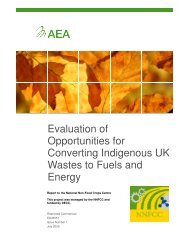Consumption and the environment (SOER2010) - European ...
Consumption and the environment (SOER2010) - European ...
Consumption and the environment (SOER2010) - European ...
Create successful ePaper yourself
Turn your PDF publications into a flip-book with our unique Google optimized e-Paper software.
Thematic assessment | <strong>Consumption</strong> <strong>and</strong> <strong>the</strong> <strong>environment</strong><br />
Summary<br />
The consumption of goods <strong>and</strong> services in EEA member countries is a major driver of global<br />
resource use — <strong>and</strong> associated <strong>environment</strong>al impacts. Growth in global trade is resulting in an<br />
increasing share of <strong>environment</strong>al pressures <strong>and</strong> impacts from <strong>European</strong> consumption taking place<br />
beyond Europe. Food <strong>and</strong> drink, housing, mobility <strong>and</strong> tourism are responsible for a large part<br />
of <strong>the</strong> pressures <strong>and</strong> impacts caused by consumption in <strong>the</strong> EU. Achieving significant reductions<br />
in <strong>environment</strong>al pressures <strong>and</strong> impacts will require changing private <strong>and</strong> public consumption<br />
patterns, to supplement gains achieved through better technology <strong>and</strong> improved production<br />
processes.<br />
Drivers <strong>and</strong> pressures<br />
<strong>Consumption</strong> is shaped by an array of complex,<br />
interrelated factors such as demographics, income <strong>and</strong><br />
prices, technology, trade, policies <strong>and</strong> infrastructure,<br />
as well as social, cultural <strong>and</strong> psychological factors.<br />
Production activities across economic sectors, including<br />
extractive industries, agriculture, energy, transport <strong>and</strong><br />
manufacturing, are directly responsible for <strong>the</strong> majority<br />
of <strong>the</strong> <strong>environment</strong>al impacts caused by <strong>the</strong> economy.<br />
However, it is private <strong>and</strong> public consumption that are<br />
<strong>the</strong> fundamental causal factors <strong>and</strong> drivers of change in<br />
production activities.<br />
<strong>Consumption</strong> leads to <strong>the</strong> direct creation of <strong>environment</strong>al<br />
pressures from <strong>the</strong> use of products <strong>and</strong> services, for<br />
example, through driving a car or heating a house with<br />
fossil fuels. Of greater magnitude, however, are <strong>the</strong><br />
indirect pressures that are created along <strong>the</strong> production<br />
chains of <strong>the</strong> goods <strong>and</strong> services consumed, including, for<br />
example, food, clothing, furniture or electricity. Both direct<br />
<strong>and</strong> indirect pressures result in <strong>environment</strong>al impacts, in<br />
particular, global warming, biodiversity degradation, soil<br />
sealing <strong>and</strong> air <strong>and</strong> water pollution. Since an increasing<br />
share of <strong>the</strong> final <strong>and</strong> intermediate goods consumed in<br />
Europe is imported, a growing proportion of impacts<br />
caused by our consumption takes place in o<strong>the</strong>r parts<br />
of <strong>the</strong> world. The average <strong>environment</strong>al footprint (an<br />
indicator of pressures from consumption) per person<br />
in EEA member countries is about double <strong>the</strong> available<br />
biocapacity (an indicator of l<strong>and</strong> which is biologically<br />
productive) of those countries.<br />
An EEA analysis of nine EU Member States (representing<br />
268 million of <strong>the</strong> EU's total 501 million people) has<br />
found that <strong>the</strong> majority of key <strong>environment</strong>al pressures<br />
caused by total national consumption can be allocated<br />
to eating <strong>and</strong> drinking, housing <strong>and</strong> infrastructure,<br />
<strong>and</strong> mobility. These three broad consumption areas are<br />
estimated to have contributed approximately two-thirds<br />
of consumption-related material use, greenhouse gas<br />
emissions, acidifying emissions <strong>and</strong> ozone precursor<br />
emissions.<br />
The reasons for <strong>the</strong>se high shares are that food <strong>and</strong> drink,<br />
housing <strong>and</strong> mobility are <strong>the</strong> areas which <strong>European</strong>s<br />
spend most on <strong>and</strong> at <strong>the</strong> same time <strong>the</strong> areas with <strong>the</strong><br />
highest pressures per euro spent. Tourism is a fourth area<br />
causing high <strong>and</strong> growing <strong>environment</strong>al impacts, both<br />
within <strong>the</strong> EU <strong>and</strong> elsewhere.<br />
A major reason why consumption negatively affects<br />
<strong>the</strong> <strong>environment</strong> <strong>and</strong> causes an over-use of resources is<br />
because <strong>the</strong> costs to society of <strong>environment</strong>al <strong>and</strong> resource<br />
degradation are not fully reflected in <strong>the</strong> prices of goods<br />
<strong>and</strong> services. Thus, many goods are relatively cheap<br />
even though <strong>the</strong>y cause major harm to <strong>the</strong> <strong>environment</strong>,<br />
ecosystems or human health.<br />
The need for sophisticated policy<br />
packages<br />
A culture of high <strong>and</strong> continuously growing levels of<br />
consumption, generally associated with well-being <strong>and</strong><br />
success, has evolved in western <strong>European</strong> countries for<br />
decades, <strong>and</strong> EU-12 Member States <strong>and</strong> <strong>the</strong> western<br />
Balkan countries are rapidly catching up.<br />
Large differences in <strong>environment</strong>al pressures from<br />
consumption, even between households with equal<br />
income levels, indicate a considerable potential for more<br />
4<br />
The <strong>European</strong> <strong>environment</strong> | State <strong>and</strong> outlook 2010








